I’ve had experience researching and writing about the origins of Filipino dishes before, but while dinuguan, Bicol express and sisig seemed straightforward enough, kinilaw / kilawin proved surprisingly complicated. What I thought would be a walk in the park has morphed into a wild ride around a vast, evolving culinary universe (Oops). 🙂
It behooves me to say therefore, that attempts to be both exhaustive and definitive have fallen short. At the most, this is but an exploratory probe into the heart of freshness.
Click on a link below to go directly to the section:
1. Definition and Base Formula
2. To Cook or Not to Cook
3. Origin and History
4. Region of Origin
5. Kinilaw vs. Kilawin
6. The Other Kilawin / Kinilaw
7. The Many Faces of Fresh
8. Kinilaw Masters
9. Fusion Country
Definition and Base Formula
In Kinilaw: A Philippine Cuisine of Freshness by Edilberto N. Alegre and Doreen G. Fernandez, kinilaw is a Visayan term that is:
“…fish/shellfish/meat etc. eaten raw as is, or with vinegar and other condiments.”
Amy Besa and Romy Dorotan, authors of Memories of Philippine Kitchens include several other elements by defining it as:
“…a selection of fresh produce, soured and combined in the moment, specific to the next moment and place.”
If we were to extract a basic formula from the combined definitions above, I suppose it would look something like this:
Fresh raw main ingredient + souring agent (optional) + condiments = kinilaw
That the ingredients must be fresh is already a given and a matter of common sense, but because of differences in regional cultures, availability of ingredients and personal preferences, there can be innumerable variations to the other elements of the basic formula.
To Cook or Not to Cook
Alegre and Fernandez refer to vinegar as the liquid fire that cooks the main ingredient. Nonetheless, kinilaw is best served when the vinegar hasn’t thoroughly seeped through. Once it does, the dish can turn rubbery depending on the main ingredient. Hence, in its best form, it should really be closer to the raw state. Most food enthusiasts I’ve asked will only accept this form of the dish and discount any others that involve cooking over fire.
Fernandez however, mentioned fire cooking as a possible recipe variation, whereby, for example, vegetables as the main ingredient may be blanched and meat may be half-cooked. In the case of fully cooked pork, beef or goat, usually grilled or boiled, Alegre suggests they may still be considered variations of kinilaw if they are taken through the process of souring and mixed with the usual condiments. This, I suppose, is subject for debate.
Origin and History
The dish most often associated with, and usually used as a synonym for kinilaw is the Central / South American ceviche. This is a dish of raw fish, marinated in citrus juice such as lime and mixed with condiments. Is kinilaw then merely a local version of this foreign dish? What is the difference between kinilaw and ceviche? To answer these questions, it’s important to revisit the origin of ceviche too.
One theory suggests that fish seasoned with salt and aji or marinated in local fermented fruit juice was already being consumed 2000 years ago in coastal areas of what is now Peru. The locals may have simply switched to the use of citrus fruits brought by Spaniards. The other origin theory for ceviche is that it may have been brought to Peru by Moorish women who had accompanied Spanish colonizers.
Traditional ceviche was marinated for a couple of hours. Modern ceviche, introduced in the 1970s by Peruvian-Japanese chefs, is served immediately after preparation.
Kinilaw is markedly different from ceviche in its use of vinegar as the main souring agent, or none at all. Also, the short marination time has been a standard kinilaw element long before it was introduced to Peru in the 70s. Nonetheless, the two dishes have obvious similarities, and the seeming historical link can be surmised. It has been suggested that Spanish colonizers and/or travelers from Mexico introduced ceviche to us.
Fernandez however, cites archeological evidence of our own which point to kinilaw being possibly a thousand years old, predating Spanish influence. The 1987 Butuan Balangay dig unearthed tabon-tabon halves together with fish bones. Tabon-tabon is a fruit abundant in Northern Mindanao, the juice extract of which is commonly used in kinilaw dishes served in some parts of Mindanao.
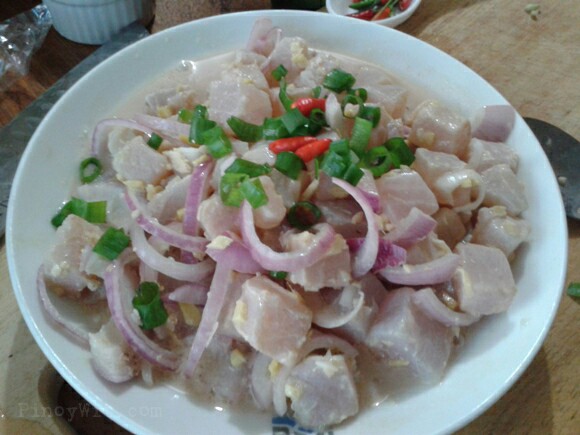
Fernandez has also presented textual evidence of kinilaw’s local origin in early dictionaries written close to the point of first contact for and by Spaniards. The Vocabulario de la lengua Tagala (1613) refers to cqilao as a sort of pickling sauce of the natives, that is, salt, vinegar and chili in which meat or fish is placed. Other dictionaries in the 1700s and 1800s contain some references to the dish. Most notable of these are the Vocabulario de la lengua Pampanga en romance (1732), which mentions quilao as eating slightly cooked meat, and the Vocabulario de la lengua Tagala (1754), which lists quilauin as a dish of meat or fish in vinegar.
Alegre helpfully adds that the dish is part of the culinary repertoire of groups largely unaffected by Spanish culture, the Ivatans and the lumad (indigenous) of the Cordillera for example, thereby proving the dish’s local origin.
In my opinion, the best evidence that kinilaw originated in our native shores may be deemed circumstantial but highly logical. There was, and still is, such an abundance of fresh food sources, that it would have been inevitable for our forefathers to discover the dish.
Indeed, I had witnessed firsthand how, in Bantayan, houses were so close to the sea that fresh catch could be hauled straight into kitchens. My immediate feeling was that cooking was superfluous, even wasteful in the midst of such fresh abundance.
Region of Origin
Can one region claim to have created kinilaw? Was it invented by one group: the Visayans, Mindanaoans, Tagalogs, Ilocanos or Pangasinense? I have not found documentary evidence yet that can pin down its origin to one area. If you think about it, this is simply too difficult to do considering the expansive scope of the dish’s nature, definition and variety, ranging from plain raw consumption to more elaborate mixes.
Is it not more likely that, surrounded by freshness everywhere, the people of each region awakened to the practice of preparing and consuming raw food in their own manner and style?
This again, is a matter open to debate.
Kinilaw vs. Kilawin
What is the difference between kinilaw and kilawin? Kinilaw is the term used in the Visayas and in many areas in Mindanao for raw or semi raw food. Kilawin is the terms used in many Tagalog regions and some of the other regions in Luzon for the same dish.
Because the Philippines is culturally diverse, it is likely that the dish may be called other terms in other places. Fernandez and Alegre record for example, the term lataven in Batanes and lawal among the Tausugs in Mindanao as regional synonyms of the dish.
The Other Kilawin / Kinilaw
I suppose it is when the two most commonly used terms for raw food are used for entirely different recipes that confusion sets in. In Ilocos, there is another dish called kilawin. My Visayan mother who has lived for many years in Northern Luzon insists that the Ilocano kilawin is not the same as the Tagalog dish of the same name. Negros Occidental kinilaw master Enting Lobotan differentiates between the two dishes too.
Ilocano kilawin is goat, beef or pork boiled, grilled, chopped and mixed with vinegar, an assortment of condiments and papait (bile). It is worth noting however, that although traditional Ilocano kilawin is cooked, Ilocanos do have their own raw fare. Several sources call this raw Ilocano dish kilawen.
In Cuyo, Palawan, there is a dish called kinilaw that has nothing in common with the similarly named Visayan dish. According to Country Cooking: Philippine Regional Cuisines by Michaela Fenix, Cuyo’s kinilaw is made up of ground beef liver, tenderloin and spleen, boiled in water and vinegar and then fried. Garlic, pepper, mint, green onions and sugar complete the mix.
The Many Faces of Fresh
I was as a young traveler to Bantayan Island when I had my first glimpse of fish kinilaw. I watched my grandfather devour a huge bony fish drowned in tuba (coconut vinegar). His steadily reddening face made me suspect that perhaps it was the alcoholic version of tuba that he had used as marinade. He was so engrossed by his meal that I was convinced he would not have noticed if a herd of cattle thundered past him.
I thought then that kinilaw always had to be fish and that it was always served plain with just vinegar. This particular research work however, has revealed the near limitless scope of the dish. Nearly anything fresh can be made into kinilaw and a wide array of souring agents and condiments can be thrown into the mix.
Aside from fish of all shapes and sizes, seafood like crabs, clams, shrimp, oysters, squid, sea urchin, abalone and scallops can be used as main ingredients. Among land animals, pork, beef and goat make the cut. The more adventurous can try abatud (coconut beetle larva) or tamilok (shipworm).
Although not everyone is likely to agree, my inquiries have revealed that some people also consider raw vegetables and unripe fruits as types of kinilaw. Examples of these include banana blossom, green mango, green papaya, radish and tomatoes.
As to souring agents, there is a broad set of options to choose from. Vinegar alone has numerous varieties. In Cebu and Cagayan de Oro, tuba, which comes from coconut is commonly used as a souring agent. Other options depending on region and availability are Bulacan’s sukang paombong from the nipa fruit, sukang Iloko from sugarcane, Surigao’s buri vinegar, and Negros’ sinamak (spiced vinegar).
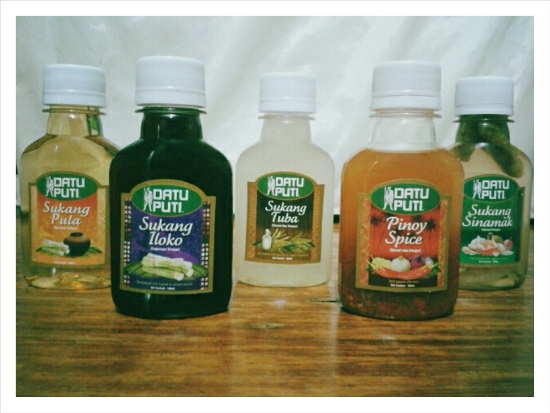
Other souring agents can be used together with or in place of vinegar. Suha / dayap (lime) and kalamansi are among the most commonly added. Other sour fruits that have found themselves included in raw food recipes include green mango, kamias, paho, green sineguelas and balimbing. In Batanes, a fruit foreign to other areas called valatinog is used.
The usual line of condiments that can be added into kinilaw are ginger, onions, chili, green onions and salt. In Hinatuan, Surigao del Sur, the wild onion called seyboring can be used in place of regular onions.
Less universally accepted additions that enjoy regional popularity are garlic, coconut milk, cucumber, radish, black beans, sugar, tomatoes and salted duck eggs. According to Fernandez, in Butuan, coconut can be toasted first before its milk is squeezed.
Other areas demonstrate an even more unique use of local ingredients. Some fruit juices and plant parts can neutralize the lansa or fishy taste, smell or feel of fish kinilaw. I am most familiar with tabon-tabon, found only in select areas in Visayas and Mindanao, and which, I do not think has an English name. It supposedly has the added ability of preventing indigestion.
Other lansa neutralizers used in other regions are sineguelas bark extract, dungon (kind of nut) pulp, pungango (small young coconut), and bakawan (a type of mangrove bark).
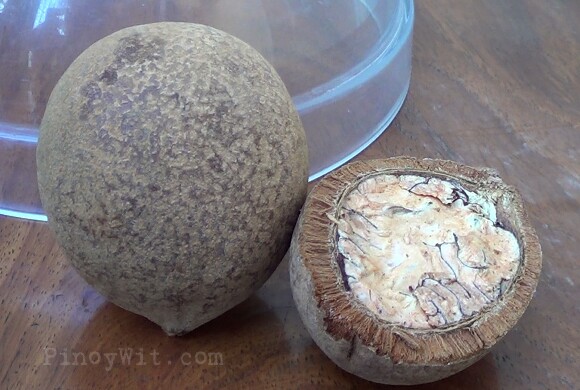
Kinilaw Masters
It’s possible there really are a thousand and one kinilaw variations mainly because anyone who professes a love for it can opt to inject his unique preferences. My mother likes her fish filleted and marinated longer than usual in cane vinegar and garlic. Any leftovers later become excellent material for inun-unan (soured fish dish cooked over fire).
My father-in-law, whose recipe appears in the video above, prepares his the traditional Kagay-anon way, but he has added his personal touch. Because he rebels against the idea of using sugar or soft drinks to sweeten kinilaw, he uses a combination of sweet, freshly harvested coconut vinegar and old stock vinegar to balance the taste.
Then there are masters who have elevated kinilaw into a whole new level of expertise, proposing the efficient and proper use of ingredients and combinations to create the perfect taste experience. Undoubtedly, the most popular of them is Enting Lobaton, whose name appears on every single reference article or piece of kinilaw literature I’ve read. From Negros Occidental, he dispenses sage advice.
Strong vinegar, he says, can be made milder with sugar, lime, salted egg or coconut milk. Mild vinegar on the other hand, can be made stronger with paho or green sineguelas. Some fish like bangus and tangigue react too fast to strong marinades and are therefore best prepared with milder souring agents. Scallops and squid both toughen when marinated; hence, lime can be used for the former while the latter can be eaten dipped quickly in vinegar. Fish with more lansa are ideally prepared with kalamansi.
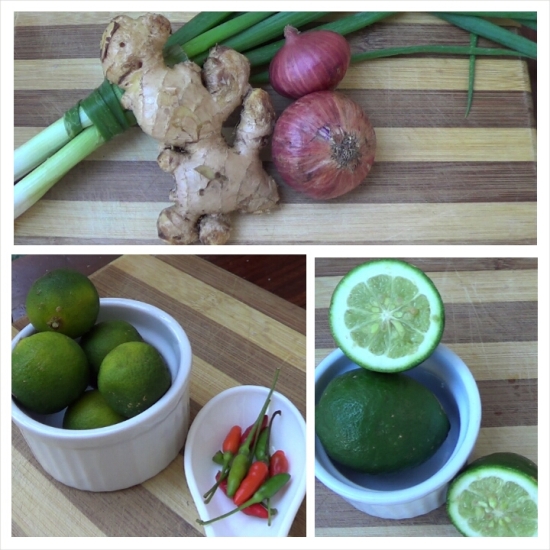
Fusion Country
Once the Pinoy has exhausted every possible permutation of a basic culinary formula, recipes move into fusion country. In some parts of Mindanao, sinuglaw is served. This is essentially traditional kinilaw with cuts of sinugba (grilled pork) mixed in. In some Visayan regions, kinilaw can be consumed with paired dishes such as cornmeal in Zamboanguita, Negros Oriental; boiled bananas or root crops in Catbalogan, Samar and Hinatuan, Surigao del Sur. More elaborate pairings include pareha, the pairing of kinilaw banana blossom and grilled bangus from Hagonoy; and sutokil, a combination of sinugba, tinola (soup-based dish of meat and vegetables) and kinilaw from the Vis-Min region.
This is as far as I dare go exploring the heart of freshness. It is a story where the beginning is difficult to trace and the end is not imminent. There is simply no end to its evolution. By all indications, kinilaw is an organic, multifaceted element that thrives within the many different sub cultures of the Filipino race. One thing is certain though, to us, the dish is an embodiment of a way of life and an indisputable evidence of nature’s abundant benevolence.
References:
1. Edilberto N. Alegre and Doreen G. Fernandez, Kinilaw: A Philippine Cuisine of Freshness (1991)
2. Amy Besa and Romy Dorotan, Memories of Philippine Kitchens: Stories and Recipes from Far and Near (2012)
3. Michaela Fenix, Country Cooking: Philippine Regional Cuisines (2014)
4. Nora V. Daza, Let’s Cook with Nora (1969)
5. Angelo Comsti, Philippine ‘kinilaw’ takes center stage in Madrid Fusion 2015
6. Kinilaw, Project Gutenberg
7. Ceviche, Wikipedia
8. Kapuso Mo Jessica Soho, The different versions of kinilaw
9. Clinton Palanca, How to make ‘kinilaw’ – from the ‘kinilaw master’ himself
10. Marketman, Ceviche of Yellow Fin Tuna a la Marketman
11. Good Samaritan, Traditional Ilocano Dish: Raw Beef Kinilaw
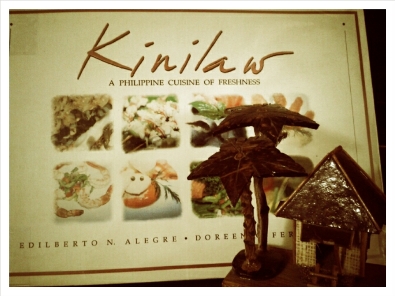
Hi Nina,
Thanks for writing and sharing all this – it’s an informative post! 🙂
I finally got my hands on a copy of Alegre and Fernandez’ “Kinilaw” last year. I highly enjoyed learning about the multitude of dimensions you could take the formula of ingredient + souring agent + condiment. That inspires me to write a book review about it!
I’m travelling to CDO soon; kilawin with prepared with tabon-tabon is something I’ll have to have!
Look forward to reading the rest of your posts – I’m particularly interested in Philippine culinary history myself!
I’m not a fan of kinilaw, but I like the amount of information and history that you included in this post.